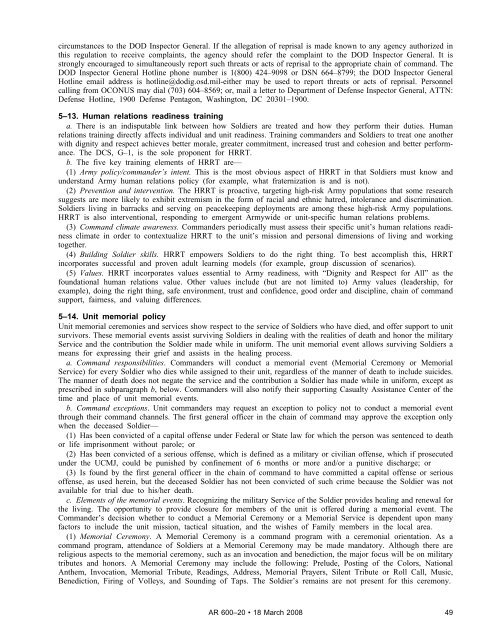AR 600-20, Army Command Policy - Army Publishing Directorate ...
AR 600-20, Army Command Policy - Army Publishing Directorate ...
AR 600-20, Army Command Policy - Army Publishing Directorate ...
Create successful ePaper yourself
Turn your PDF publications into a flip-book with our unique Google optimized e-Paper software.
circumstances to the DOD Inspector General. If the allegation of reprisal is made known to any agency authorized in<br />
this regulation to receive complaints, the agency should refer the complaint to the DOD Inspector General. It is<br />
strongly encouraged to simultaneously report such threats or acts of reprisal to the appropriate chain of command. The<br />
DOD Inspector General Hotline phone number is 1(800) 424–9098 or DSN 664–8799; the DOD Inspector General<br />
Hotline email address is hotline@dodig.osd.mil-either may be used to report threats or acts of reprisal. Personnel<br />
calling from OCONUS may dial (703) 604–8569; or, mail a letter to Department of Defense Inspector General, ATTN:<br />
Defense Hotline, 1900 Defense Pentagon, Washington, DC <strong>20</strong>301–1900.<br />
5–13. Human relations readiness training<br />
a. There is an indisputable link between how Soldiers are treated and how they perform their duties. Human<br />
relations training directly affects individual and unit readiness. Training commanders and Soldiers to treat one another<br />
with dignity and respect achieves better morale, greater commitment, increased trust and cohesion and better performance.<br />
The DCS, G–1, is the sole proponent for HRRT.<br />
b. The five key training elements of HRRT are—<br />
(1) <strong>Army</strong> policy/commander’s intent. This is the most obvious aspect of HRRT in that Soldiers must know and<br />
understand <strong>Army</strong> human relations policy (for example, what fraternization is and is not).<br />
(2) Prevention and intervention. The HRRT is proactive, targeting high-risk <strong>Army</strong> populations that some research<br />
suggests are more likely to exhibit extremism in the form of racial and ethnic hatred, intolerance and discrimination.<br />
Soldiers living in barracks and serving on peacekeeping deployments are among these high-risk <strong>Army</strong> populations.<br />
HRRT is also interventional, responding to emergent <strong>Army</strong>wide or unit-specific human relations problems.<br />
(3) <strong>Command</strong> climate awareness. <strong>Command</strong>ers periodically must assess their specific unit’s human relations readiness<br />
climate in order to contextualize HRRT to the unit’s mission and personal dimensions of living and working<br />
together.<br />
(4) Building Soldier skills. HRRT empowers Soldiers to do the right thing. To best accomplish this, HRRT<br />
incorporates successful and proven adult learning models (for example, group discussion of scenarios).<br />
(5) Values. HRRT incorporates values essential to <strong>Army</strong> readiness, with “Dignity and Respect for All” as the<br />
foundational human relations value. Other values include (but are not limited to) <strong>Army</strong> values (leadership, for<br />
example), doing the right thing, safe environment, trust and confidence, good order and discipline, chain of command<br />
support, fairness, and valuing differences.<br />
5–14. Unit memorial policy<br />
Unit memorial ceremonies and services show respect to the service of Soldiers who have died, and offer support to unit<br />
survivors. These memorial events assist surviving Soldiers in dealing with the realities of death and honor the military<br />
Service and the contribution the Soldier made while in uniform. The unit memorial event allows surviving Soldiers a<br />
means for expressing their grief and assists in the healing process.<br />
a. <strong>Command</strong> responsibilities. <strong>Command</strong>ers will conduct a memorial event (Memorial Ceremony or Memorial<br />
Service) for every Soldier who dies while assigned to their unit, regardless of the manner of death to include suicides.<br />
The manner of death does not negate the service and the contribution a Soldier has made while in uniform, except as<br />
prescribed in subparagraph b, below. <strong>Command</strong>ers will also notify their supporting Casualty Assistance Center of the<br />
time and place of unit memorial events.<br />
b. <strong>Command</strong> exceptions. Unit commanders may request an exception to policy not to conduct a memorial event<br />
through their command channels. The first general officer in the chain of command may approve the exception only<br />
when the deceased Soldier—<br />
(1) Has been convicted of a capital offense under Federal or State law for which the person was sentenced to death<br />
or life imprisonment without parole; or<br />
(2) Has been convicted of a serious offense, which is defined as a military or civilian offense, which if prosecuted<br />
under the UCMJ, could be punished by confinement of 6 months or more and/or a punitive discharge; or<br />
(3) Is found by the first general officer in the chain of command to have committed a capital offense or serious<br />
offense, as used herein, but the deceased Soldier has not been convicted of such crime because the Soldier was not<br />
available for trial due to his/her death.<br />
c. Elements of the memorial events. Recognizing the military Service of the Soldier provides healing and renewal for<br />
the living. The opportunity to provide closure for members of the unit is offered during a memorial event. The<br />
<strong>Command</strong>er’s decision whether to conduct a Memorial Ceremony or a Memorial Service is dependent upon many<br />
factors to include the unit mission, tactical situation, and the wishes of Family members in the local area.<br />
(1) Memorial Ceremony. A Memorial Ceremony is a command program with a ceremonial orientation. As a<br />
command program, attendance of Soldiers at a Memorial Ceremony may be made mandatory. Although there are<br />
religious aspects to the memorial ceremony, such as an invocation and benediction, the major focus will be on military<br />
tributes and honors. A Memorial Ceremony may include the following: Prelude, Posting of the Colors, National<br />
Anthem, Invocation, Memorial Tribute, Readings, Address, Memorial Prayers, Silent Tribute or Roll Call, Music,<br />
Benediction, Firing of Volleys, and Sounding of Taps. The Soldier’s remains are not present for this ceremony.<br />
<strong>AR</strong> <strong>600</strong>–<strong>20</strong> 18 March <strong>20</strong>08<br />
49
















